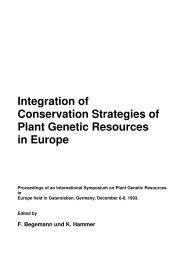Agrobiodiversität in Deutschland - Genres
Agrobiodiversität in Deutschland - Genres
Agrobiodiversität in Deutschland - Genres
Sie wollen auch ein ePaper? Erhöhen Sie die Reichweite Ihrer Titel.
YUMPU macht aus Druck-PDFs automatisch weboptimierte ePaper, die Google liebt.
136 | Mart<strong>in</strong> Scheele<br />
<strong>Agrobiodiversität</strong> im Rahmen der Geme<strong>in</strong>samen Agrarpolitik<br />
natürlichen Ressourcen zu den Hauptzielsetzungen der Geme<strong>in</strong>samen Agrarpolitik<br />
gehört. Es geht um e<strong>in</strong> umweltfreundliches Wachstum im Agrarsektor,<br />
unter Vermeidung von Umweltschäden, sowie um die Erhaltung der<br />
natürlichen Ressourcen, e<strong>in</strong>schließlich der biologischen Vielfalt.<br />
Abstract<br />
Over the recent decades, the <strong>in</strong>tegration of environmental requirements has<br />
become <strong>in</strong>creas<strong>in</strong>gly the determ<strong>in</strong><strong>in</strong>g factor of the Common Agricultural Policy<br />
(CAP) and its further development. Environmental measures with<strong>in</strong> the CAP<br />
have a ma<strong>in</strong> focus on the preservation of habitats and landscape as well as on<br />
the conservation of biodiversity.<br />
By the end of the 1980s habitat and landscape management measures became<br />
part of the Policy for Rural Development. The reform of the CAP <strong>in</strong> 1992 <strong>in</strong>troduced<br />
the agri-environmental measures which offer farmers, on voluntary<br />
basis, a payment for environmental services exceed<strong>in</strong>g mandatory standards.<br />
This <strong>in</strong>cludes measures for the conservation of genetic diversity by cultivation<br />
and breed<strong>in</strong>g of endangered crops and breeds.<br />
In 2004, a specific <strong>in</strong>strument for the conservation of agrobiodiversity- the<br />
Community Programme for the conservation, characterization, collection<br />
and utilization of genetic resources for agriculture- was started. In the current<br />
implementation period, 180 scientific <strong>in</strong>stitutions participate <strong>in</strong> 17 projects<br />
for the conservation of genetic resources. 12 projects are dedicated to the ex<br />
situ conservation of crops, <strong>in</strong>clud<strong>in</strong>g cereals (rice, oat), fruits (strawberry,<br />
blackberry, nuts and almond), leafy vegetables, grapev<strong>in</strong>e, spices (saffron) and<br />
forest plants. Their focus lies on the establishment and the consolidation of<br />
gene banks and the coord<strong>in</strong>ation of crop-specific databases. 5 projects focus on<br />
the ex situ conservation of genetic resources of farm animals (cattle, pig, and<br />
sheep) with a ma<strong>in</strong> emphasis on the establishment, consolidation and coord<strong>in</strong>ation<br />
of sperm banks. In addition, a network for the coord<strong>in</strong>ation of scientific<br />
activities for the conservation of genetic resources exists.<br />
Special challenges arise from the steep <strong>in</strong>crease of food demand forecasted for<br />
the com<strong>in</strong>g decades. This trend co<strong>in</strong>cides with a simultaneous <strong>in</strong>crease <strong>in</strong> the<br />
demand for bio-energy and biomass. The expected consequences will be an<br />
<strong>in</strong>creas<strong>in</strong>g <strong>in</strong>tensification of production and <strong>in</strong>creas<strong>in</strong>g land use competition.<br />
This development will result <strong>in</strong> an <strong>in</strong>creased pressure on natural resources such<br />
as soil and water, as well as <strong>in</strong> the degradation of habitats and <strong>in</strong> a decl<strong>in</strong>e of<br />
biological diversity. Climate change is likely to <strong>in</strong>tensify these effects even more.<br />
This future scenario for agriculture requires special efforts to facilitate susta<strong>in</strong>able<br />
growth. This does not only concern technological and organizational<br />
progress <strong>in</strong> the core area of primary agricultural production; it concerns also<br />
the conservation of natural resources, especially soil, water and genetic diversity.<br />
Cop<strong>in</strong>g with these challenges requires concerted actions of policy, science, the<br />
private sector, and farmers. In this respect, clear requirements have been formulated<br />
by policy. In its Communication “Common Agricultural Policy 2020”, the<br />
European Commission underl<strong>in</strong>ed that the susta<strong>in</strong>able management of natural<br />
resources is one of the ma<strong>in</strong> objectives of the CAP. Key issues are environmentally-friendly<br />
growth <strong>in</strong> agriculture, mitigation of environmental damage, and the<br />
conservation of natural resources, <strong>in</strong>clud<strong>in</strong>g biological diversity.<br />
Mart<strong>in</strong> Scheele | 137










